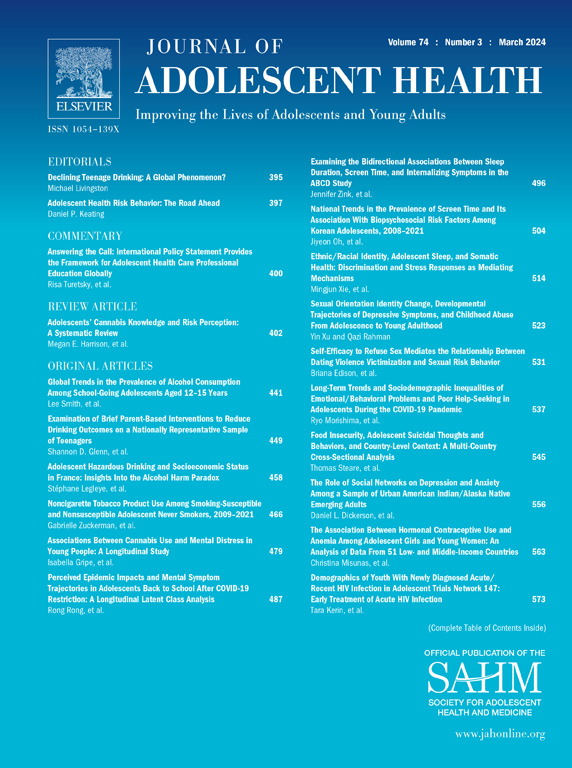Sleep as a Protective Factor: Multiple Forms of Discrimination and Substance Use Intention Among Racially and Ethnically Minoritized United States Youth
IF 5.5
2区 医学
Q1 PEDIATRICS
引用次数: 0
Abstract
Purpose
Research has rarely examined biobehavioral factors in mitigating substance use (SU) risks associated with discrimination among racially and ethnically minoritized youth. This study investigated sleep duration as a potential moderator of the association between multiple forms of discrimination based on race and ethnicity, sexual orientation, and weight (i.e., multiple discrimination) and subsequent SU intention in this population.
Methods
Data were drawn from a national, longitudinal sample of racially and ethnically minoritized early adolescents (N = 3,495, Mage = 11.52 years) participating in the Adolescent Brain Cognitive Development Study. Multiple discrimination was assessed through aggregated youth reports at 1-year follow-up (Y1) and 2-year follow-up (Y2). Sleep duration was assessed at Y2 via self-reports in the full sample and actigraphy over 3 weeks in a subsample (N = 1,404). Youth reported SU intention at Y2 and 3-year follow-up (Y3). Relevant sociodemographic and psychosocial covariates were included.
Results
Path analyses showed that more exposure to multiple discrimination was associated with greater subsequent SU intention, controlling for prior SU intention levels. However, this association was only significant among adolescents with shorter sleep duration on weekdays, not among those who slept longer (above 9.6 hours based on self-reports or 7.5 hours based on actigraphy) on weekdays. Actigraphy sleep duration mean and variability also exhibited nuanced linkages with subsequent SU intention.
Discussion
Findings highlighted sleep duration as a promising lever of change for preventative interventions aiming to curb SU among racially and ethnically minoritized youth in early development.
睡眠作为一种保护因素:多种形式的歧视与美国少数种族和族裔青少年的药物使用意向》(Multiple Forms of Discrimination and Substance Use Intention Among Racially and Ethnic Minoritized United States Youth)。
目的:研究很少检查生物行为因素,以减轻与种族和少数民族青年歧视相关的物质使用(SU)风险。本研究调查了睡眠时间是否可能调节基于种族和民族、性取向和体重的多种形式歧视(即多重歧视)与随后的自杀倾向之间的关系。方法:数据来自参加青少年大脑认知发展研究的全国少数民族和少数民族早期青少年(N = 3495,年龄= 11.52)的纵向样本。通过1年随访(Y1)和2年随访(Y2)的汇总青年报告来评估多重歧视。在Y2时,通过整个样本的自我报告和子样本3周的活动记录仪评估睡眠时间(N = 1,404)。青少年在Y2和3年随访(Y3)时报告了SU意向。相关的社会人口学和社会心理协变量包括在内。结果:通径分析显示,在控制了先前的自杀倾向水平后,更多的多重歧视暴露与更大的后续自杀倾向相关。然而,这种关联仅在工作日睡眠时间较短的青少年中有意义,而在工作日睡眠时间较长的青少年(根据自我报告超过9.6小时,根据活动记录仪超过7.5小时)中则没有意义。活动描记睡眠持续时间均值和变异性也显示出与后续睡眠意图的微妙联系。讨论:研究结果强调,睡眠时间作为预防干预措施的一个有希望的改变杠杆,旨在遏制种族和少数民族青少年在早期发育中的SU。
本文章由计算机程序翻译,如有差异,请以英文原文为准。
求助全文
约1分钟内获得全文
求助全文
来源期刊

Journal of Adolescent Health
医学-公共卫生、环境卫生与职业卫生
CiteScore
10.40
自引率
3.90%
发文量
526
审稿时长
46 days
期刊介绍:
The Journal of Adolescent Health is a scientific publication dedicated to enhancing the health and well-being of adolescents and young adults. Our Journal covers a broad range of research topics, spanning from the basic biological and behavioral sciences to public health and policy. We welcome a variety of contributions, including original research papers, concise reports, literature reviews, clinical case reports, opinion pieces, and letters to the editor. We encourage professionals from diverse disciplines such as Anthropology, Education, Ethics, Global Health, Health Services Research, Law, Medicine, Mental and Behavioral Health, Nursing, Nutrition, Psychology, Public Health and Policy, Social Work, Sociology, and Youth Development to share their expertise and contribute to our mission of promoting adolescent health. Moreover, we value the voices of young individuals, family and community members, and healthcare professionals, and encourage them to submit poetry, personal narratives, images, and other creative works that provide unique insights into the experiences of adolescents and young adults. By combining scientific peer-reviewed research with creative expressions, our Journal aims to create a comprehensive understanding of the challenges and opportunities in adolescent and young adult health.
 求助内容:
求助内容: 应助结果提醒方式:
应助结果提醒方式:


